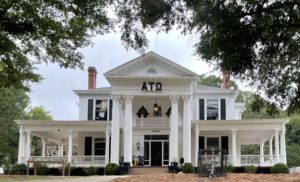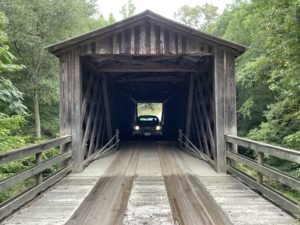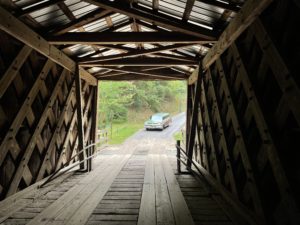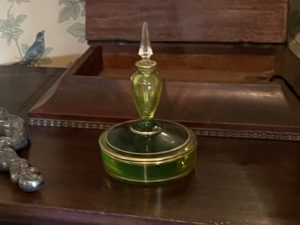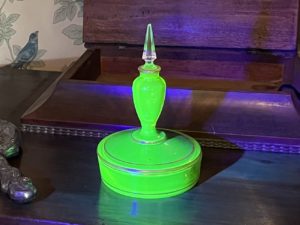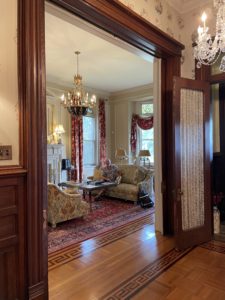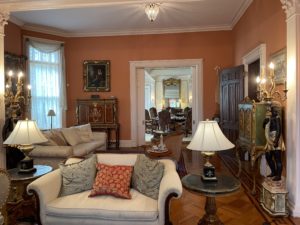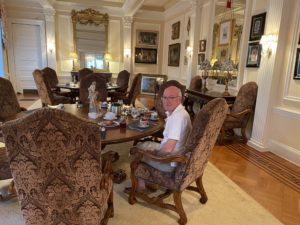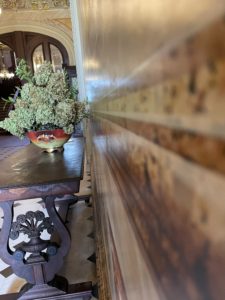In which Sid and Doris do not overdose on Greek Revival mansions by cunningly visiting the Italianate Hay House, and rest up in a B&B mansion they have all to themselves.
 Leaving Athens towards the Athens-Macon Antebellum Trail we pause to see a Confederate double barrelled canon. The plan was that the two barrels would simultaneously fire a ball with yards of chain in between that would ‘mow soldiers like grass’. In tests one barrel would fire first, flying off trailing the chain and second ball before the other barrel fired. The second barrel was then effectively a blank. They still have it and it still doesn’t work, and unsurprisingly it is the only one of its kind.
Leaving Athens towards the Athens-Macon Antebellum Trail we pause to see a Confederate double barrelled canon. The plan was that the two barrels would simultaneously fire a ball with yards of chain in between that would ‘mow soldiers like grass’. In tests one barrel would fire first, flying off trailing the chain and second ball before the other barrel fired. The second barrel was then effectively a blank. They still have it and it still doesn’t work, and unsurprisingly it is the only one of its kind.
Driving out through the lavishly-endowed Georgia university campus Doris is delighted to find an entire street full of frat and sorority houses (the university is 58% female) with their Greek lettering, looking just like the movies only more so.
First stop is a photo-opportunity for Mr G on a covered bridge whose -est is being one of the few covered bridges in this part of Georgia which still don’t have any metal supporting their roadbed. Doris crosses before the renownedly heavy Mr G, just in case.
Our house stop is Heritage Hall in Madison. Built in 1811 when the Creek ‘Indians’ were still fighting the incomers, the house was built by land owners at a time when nearly half the population of Madison County was enslaved.
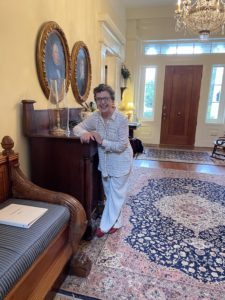 Sara Lynn Holbert, a leading light in the local historical society and some-time teacher, is our guide. Fantastically on top of her topic and charming, telling us about life in the house, showing us period clothes and kweeyults. You should visit Madison. They paved the streets in 1920 so it is not dusty or muddy.
Sara Lynn Holbert, a leading light in the local historical society and some-time teacher, is our guide. Fantastically on top of her topic and charming, telling us about life in the house, showing us period clothes and kweeyults. You should visit Madison. They paved the streets in 1920 so it is not dusty or muddy.
S and D might be described as slightly geeky so are thrilled to see a piece of uranium glass glow green under Sara Lynn’s ultra violet light (which of course people did not routinely have when they were originally producing uranium glass – they just liked the green colour).
On the way to root beer lunch S and D visit the Sheriff’s office and courtrooms. Many seats for kibitzers so justice is seen to be done.
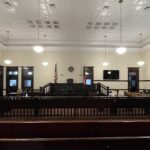 The local paper says police officers attended a home where neighbours reported fighting, to find a couple arguing violently over how to tidy up the house for the visit of the child protection officer. As we saw outside a church: Count your blessings, not your problems. Amen. Sid, started on second base. Do they really say that?
The local paper says police officers attended a home where neighbours reported fighting, to find a couple arguing violently over how to tidy up the house for the visit of the child protection officer. As we saw outside a church: Count your blessings, not your problems. Amen. Sid, started on second base. Do they really say that?
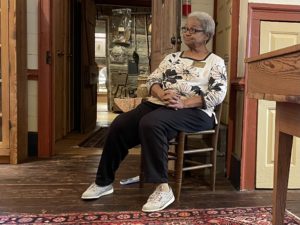 The Uncle Remus Museum is on our route at Eatonton and as it is made of three slave cabins pushed together there are no columns. Uncle Remus told the Brer Rabbit and critters stories, as relayed by Joel Chandler Harris who is said to have heard them from slaves. Joel, born 1848, was mentored by Joseph Addison Turner who put the boy to work as a printer’s devil and gave him a college education. Our docent was also keen to tell stories and had developed a character of her own that rather got in the way of the history, selon Sid.
The Uncle Remus Museum is on our route at Eatonton and as it is made of three slave cabins pushed together there are no columns. Uncle Remus told the Brer Rabbit and critters stories, as relayed by Joel Chandler Harris who is said to have heard them from slaves. Joel, born 1848, was mentored by Joseph Addison Turner who put the boy to work as a printer’s devil and gave him a college education. Our docent was also keen to tell stories and had developed a character of her own that rather got in the way of the history, selon Sid.
 On to Macon (rhymes with Bacon) where we stay at the Burke Mansion. From the outside it looks rather unloved and run down. Inside the welcome is great and as Paul’s only guests we have the mansion to ourselves with Mr Jolly parked in style in the porch. We are charmed and decide to stay a second night to catch up on the admin and to visit some of Macon’s sights.
On to Macon (rhymes with Bacon) where we stay at the Burke Mansion. From the outside it looks rather unloved and run down. Inside the welcome is great and as Paul’s only guests we have the mansion to ourselves with Mr Jolly parked in style in the porch. We are charmed and decide to stay a second night to catch up on the admin and to visit some of Macon’s sights.
Breakfast is taken in great splendour.
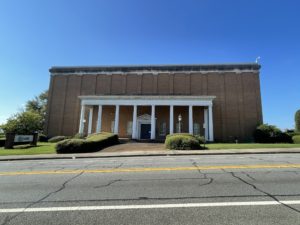 Macon is sticky with pillared mansions – and you know you are in the true antebellum country when even the local telephone exchange has a pillared frontage.
Macon is sticky with pillared mansions – and you know you are in the true antebellum country when even the local telephone exchange has a pillared frontage.
To avoid mansion overdose we visit St Joseph’s Catholic Church with its Bavarian windows, 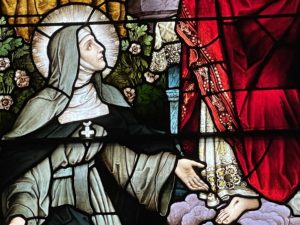 Italian marble and joyful painting sponsored by the Irish and German families who came to the area in the late 19th century.
Italian marble and joyful painting sponsored by the Irish and German families who came to the area in the late 19th century.
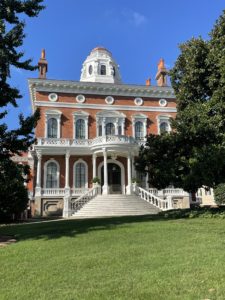 The big visit in Macon is the Johnston Hay House, owned by the people who owned the town. This was true though it passed through several prominent families.
The big visit in Macon is the Johnston Hay House, owned by the people who owned the town. This was true though it passed through several prominent families.
William Johnston made his money from railroads, banking and utilities. In 1851, when he married Anne Tracy, twenty years his junior, they went on a three year honeymoon through Europe buying stuff and having ideas for their new home. The house, all 18,000 square feet, four floors and 18 main rooms, was designed in New York with Italian Renaissance style and best current domestic technology such as air conditioning and an elevator.
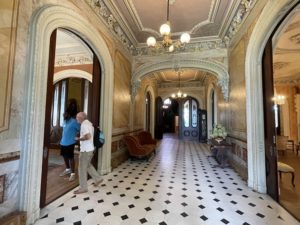 The Fulton and Hays families continued to update the house ‘til about 1962 when Mrs Hays died. Different rooms have been decorated to reflect the house at different times under each of the families. Our docent (volunteer guides, for any English readers) is new and being coached. Between the two we get a detailed visit as the guys show us the design, craftsmanship and shortcuts in the house.
The Fulton and Hays families continued to update the house ‘til about 1962 when Mrs Hays died. Different rooms have been decorated to reflect the house at different times under each of the families. Our docent (volunteer guides, for any English readers) is new and being coached. Between the two we get a detailed visit as the guys show us the design, craftsmanship and shortcuts in the house.
The trompe l’oeil marble walls are very impressive, and in fact it proves to be somewhat fiddly for Doris to get a picture which shows you that the wall is actually flat.
We get to see the point in the painting at which the Civil War broke out and the painters went back to Europe. Johnston was not a supporter of the Confederacy, perhaps because his businesses were not dependent on free labour, and there are a few hints in the decor. Either way, Macon was not burned. We pay an extra $5 each for the tour of the upper floors which have not yet been conserved, 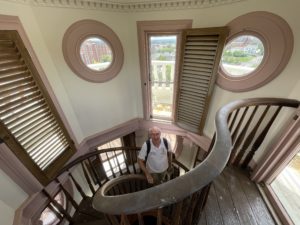 yea unto the topmost level of the cuploa. The upper floors were not for staff (who would have lived in segregated housing outside) but for guests. They were built cramped and with low ceilings so as to dissuade guests from settling in, with bathrooms elsewhere in the house. The guest bedroom windows are the little circular ones in the picture at the top.
yea unto the topmost level of the cuploa. The upper floors were not for staff (who would have lived in segregated housing outside) but for guests. They were built cramped and with low ceilings so as to dissuade guests from settling in, with bathrooms elsewhere in the house. The guest bedroom windows are the little circular ones in the picture at the top.
Dinner is at the bar in Kudzu, which is an invasive vine brought in to reduce soil erosion and now an invasive pest through the South.
We stay long enough to let today’s storm mostly pass through and squelch back to our personal mansion past some unexplained camels on an Egyptian-themed building.
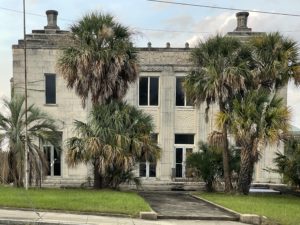 To balance up the antebellum history from the tour, you may enjoy this article from the New Statesman: why-gone-with-the-wind-is-american-cultures-original-sin.
To balance up the antebellum history from the tour, you may enjoy this article from the New Statesman: why-gone-with-the-wind-is-american-cultures-original-sin.
